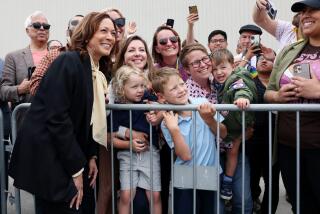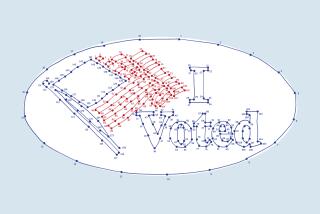Anemic Turnout of 36% Is Predicted for Tuesday
SACRAMENTO — Despite a dramatic race among three Republicans fighting to become governor, only about one in three registered voters are expected to cast ballots in California’s primary election Tuesday.
If the 36% turnout prediction holds up, voter participation in the contest would rank as the second-lowest ever for a California election. In the 1994 gubernatorial primary, just 35% of registered voters went to the polls.
“There is nothing I am more concerned about ... than the decline in voter participation,” Secretary of State Bill Jones said Wednesday in announcing his forecast.
“Especially in light of 9/11 and all the flag-waving and patriotism, there is no reason not to get out and vote.”
In making their predictions before each election, officials weigh a variety of factors, including the weather, the presence of high-interest ballot measures and possible distractions for voters.
Turnout is likely to suffer this year because the primary is earlier than ever, there is no competition for the Democratic gubernatorial nomination and many Californians have been focused on the just-concluded Winter Olympics, Jones said.
Another indicator of apathy is that requests for absentee ballots--which have risen steadily in recent years--have remained flat in most counties and declined in some, Jones said.
“There has been a lot going on--the holidays, the Super Bowl, the Olympics, the tragedies [of 9/11],” Jones said. “But that’s no excuse for Californians not to exercise their right to vote.”
Although predicting turnout is not done by a mathematical formula, the forecasts usually come within a few percentage points of the actual number.
That makes such guesswork of great interest to the GOP candidates duking it out for the chance to take on Gov. Gray Davis in November--Jones, businessman Bill Simon Jr. and former Los Angeles Mayor Richard Riordan.
A recent Times poll showed that with a moderate turnout--41% of likely Republican voters--Riordan and Simon were tied, with Jones finishing a distant third. But if only 37% cast ballots, Simon would lead Riordan 29% to 26%, according to the poll.
Many political consultants have grumbled that the unusually early primary has left voters unaware that there is an election coming up.
Kevin Spillane, political director for Riordan, said the short window of time between the holidays and March 5 “makes it hard to get your message out and make the campaign relevant in people’s lives.”
Jeff Flint, a strategist for Simon, said the campaign’s polling and focus groups suggest “many people, even interested and educated people who typically vote, have no idea there’s an election next week.” To help voters tune in, state Sen. Ross Johnson (R-Irvine) wants to move the date of future gubernatorial primaries.
Under a bill he introduced this month, the presidential primary would remain in March but all other offices would have their primary the second week of September.
“Most Californians are just not ready to focus on a primary when the general election is eight months away,” said Johnson, who has carried similar legislation in the past. “It’s crazy.”
Johnson said delaying the primary might also compel candidates to avoid negative advertising--one factor often blamed for the decline in turnout.
Under today’s schedule, a politician can run negative ads in the primary campaign and count on voters forgetting them by the general election in November.
“If the two elections were closer in time, people would remember how a candidate behaved in a primary,” Johnson said.
California used to have a June primary, but both political parties favored moving it to March as a way to gain clout in the presidential nominating process.
In 1996, the primary was held in late March and had virtually no effect on the presidential contest.
Another bill, in 1998, moved it to early March, and in 2000 President Bush clinched the GOP nomination here.
More to Read
Get the L.A. Times Politics newsletter
Deeply reported insights into legislation, politics and policy from Sacramento, Washington and beyond. In your inbox three times per week.
You may occasionally receive promotional content from the Los Angeles Times.










